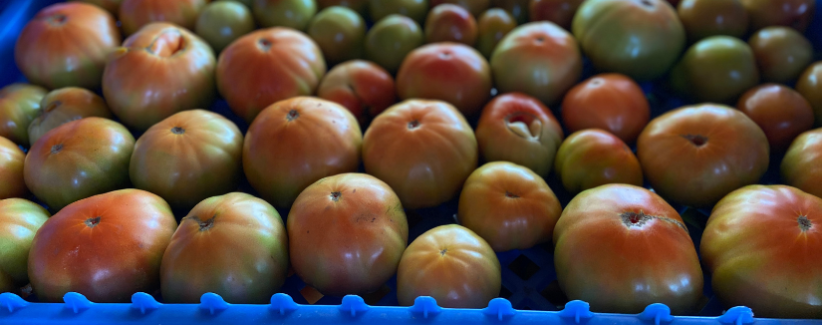A Throughline from Food Access to Health Equity

We know that food security in Massachusetts—and throughout the country—is caused by many interconnected social and economic conditions. The effects of the pandemic have added yet another layer of complexity to the issue.
Looking at the populations that have been hit hardest by both food insecurity and COVID-19, it is clear that access to food—or the lack thereof—does not affect everyone or every community in the same way. The pandemic has shown the significant disparities that exist in our state—and has exacerbated those disparities. Communities of color, LGBTQIA+ folks, women, and children have faced the consequences of the pandemic and of food insecurity at higher rates than other groups.
In recent months, as vaccine access has widened and the state has reopened, household food insecurity rates have been slowly declining. The food insecurity rate in Massachusetts has dropped from 17.5 percent in December 2020, to 14.4 percent this May, according to Project Bread.
Food insecurity among households with children declined from its mid-pandemic high of 21.8 percent last November, but it has been slowly rising again since April of this year.
At the same time, people of color are disproportionately experiencing the long-term effects of the crisis: Minority households are recovering from the pandemic at significantly slower rates than white households. From December to May, Project Bread reports that one in seven white households with children were food insecure, compared to nearly one in three Black and Latinx households with children.

The pandemic has brought greater attention to health equity and has given new energy to the conversation about social determinants of health—meaning the conditions in the places where people live, learn, and work that affect a wide range of health outcomes, as defined by the CDC. These factors generally fall outside the traditional health care system but can determine needs related to it—including things like access to housing, quality education, employment, and nutritious food.
We know that hunger and food insecurity can have harmful effects on a person’s health. Lack of access to healthy foods can lead to nutrient-deficient diets that contribute to heart disease, diabetes, obesity, and other illnesses. As the Washington Post recently wrote, “People who are food insecure are at highest risk for chronic diseases… Black, Latino, and Native American people, and residents of rural and lower-income areas, suffer the greatest disparities in food and nutrition insecurity, a problem that has been exacerbated by the pandemic.”
Locally, conversations around hunger relief and food access have increasingly focused on their implications for equitable community health outcomes.
The Massachusetts state legislature is currently considering a bill to make school meals free for all students regardless of need. If passed, this would replace the current need-based model used by the state, and would make Massachusetts the third state—after California and Maine—to adopt such measures.
Advocates consider free school lunch to be critical to student health and well-being, especially for under-resourced and low-income students, and studies show that receiving free or reduced-price school lunches reduces food insecurity, obesity rates, and poor overall health. The pandemic revealed the critical role that school meals have played in filling the racial gap in food access, especially when that access was disrupted as schools moved to remote learning.
Not only is our current situation untenable, but returning to a normal that existed before the pandemic—when one in 12 people experienced food insecurity—is equally unacceptable.
In Boston—where former mayor Marty Walsh declared racism a public health crisis—the city’s COVID-19 Health Inequities Task Force recently recommended that the city eliminate health disparities by addressing the root causes of structural inequity.
Among their chief findings is the need to eliminate food insecurity. The task force wrote that food insecurity and poor nutrition, which have increased significantly because of the pandemic, are associated with several chronic illnesses that put people at greater risk for the more severe complications of COVID-19. And hardest hit among those affected are communities of color, undocumented individuals, LGBTQIA+ folks, children, and the elderly.
The report proposed “a vision for a racism-free future, one in which one’s race, national origin, immigration status, gender, sexual orientation, English language proficiency, level of ability, or zip code does not determine one’s health and wellness.”
The pandemic continues to shine a spotlight on the ways that food security and health are intertwined, but also on the inequitable ways that resources are distributed. Acknowledging the role of structural racism in our food system and how it has created the current landscape of health and access disparity is fundamental to our work to fight hunger.

At Gaining Ground, we understand that even as life in Massachusetts has returned to a semblance of normalcy, food security remains a critical, daily issue for many individuals and families throughout the region. For communities hardest hit by the pandemic and long-standing conditions of oppression, this is especially true. Not only is our current situation untenable, but returning to a normal that existed before the pandemic—when one in 12 people experienced food insecurity—is equally unacceptable.
In an equitable world, no one should go hungry.
We believe that the food we grow nourishes not just individuals, but whole communities, and we continue to envision and work toward a future where everyone has equitable access to fresh, delicious, nutrient-dense food.